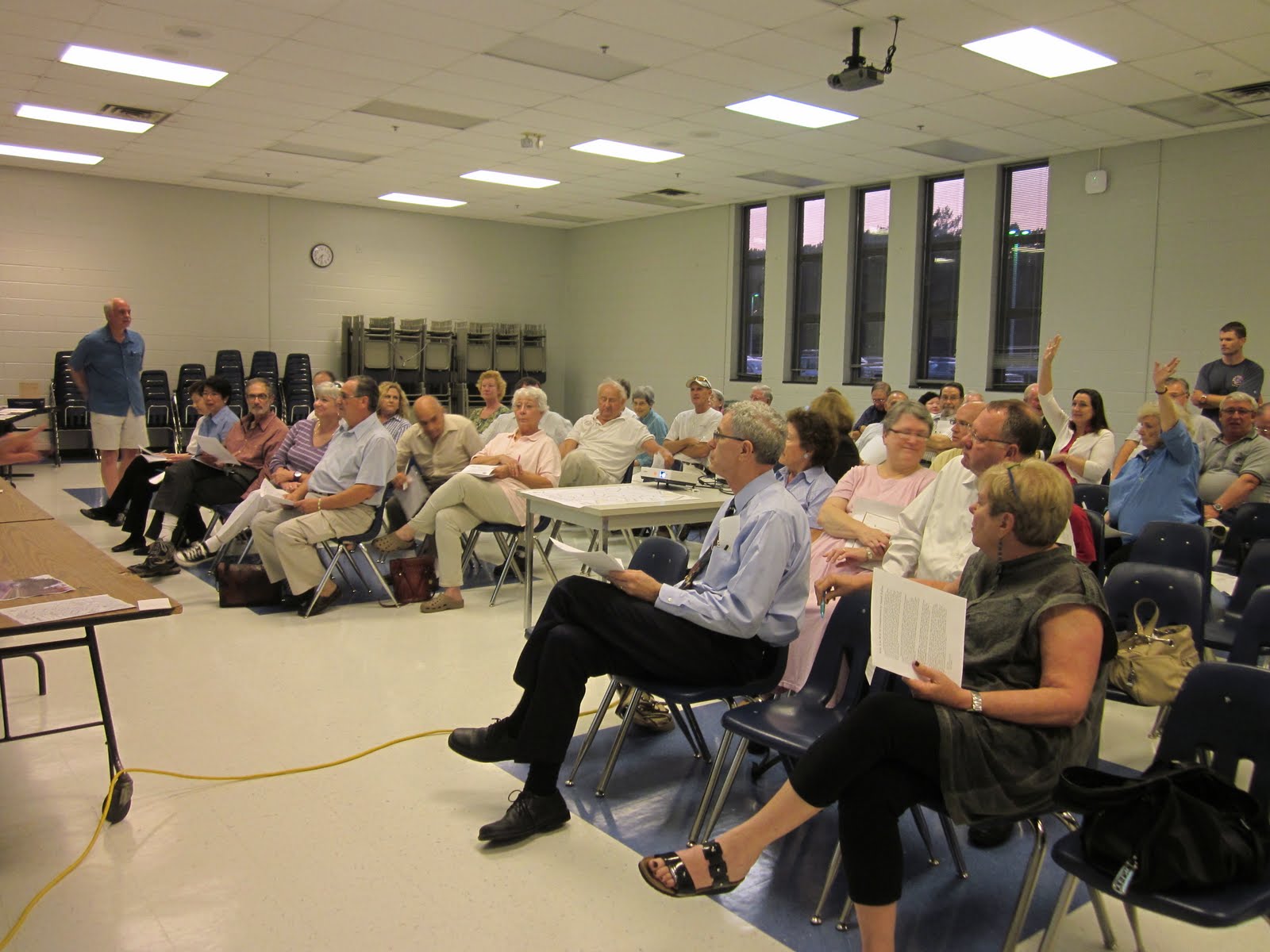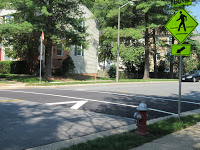 |
Ravenwood Park residents debate the merits of speed tables
at a meeting at JEB Stuart High School. |
A meeting of the Ravenwood Park Citizens Association (RPCA) Monday evening to discuss a proposal for “traffic calming devices” on Patrick Henry Drive was anything but calm.
Several local residents who opposed the devices repeatedly yelled during the meeting, interrupting the speakers. One man screamed that the voting process was “patently unconstitutional” before storming out of the room.
Traffic calming in residential neighborhoods does have a tendency to get people riled up. Last year a man in Springfield was charged with
murdering a neighbor who had been instrumental in bringing speed humps to their street, although that apparently wasn’t the only source of their conflict.
Guy Mullinax, a transportation planner with the Fairfax County Department of Transportation, said traffic calming measures are approved by about 14 communities a year in the county, and the Sept. 12 RPCA meeting was no more or less contentious than the average discussion on this topic.
The RPCA had formed a task force to consider options for dealing with the increased traffic and speeding through their Falls Church neighborhood, much of it caused by drivers seeking to avoid congestion on Leesburg Pike.
 |
| Patrick Henry Drive |
The task force had recommended that two “speed tables” be installed on Patrick Henry Drive—one near the Sargent Drive intersection, and the other between White Street and Ravenwood Drive.
A traffic analysis found the average speed on Patrick Henry is 36 mph, while the speed limit is 25 mph. The average speed and traffic volume on that street met the county’s threshold for installing traffic calming devices if the property owners agree.
People who live within a clearly defined area surrounding Patrick Henry Drive—encompassing about 290 houses—will have a chance to vote on the speed table proposal. Each eligible household gets one vote. For the measure to pass, at least 50 percent of those who received ballots have to return them, and at least 60 percent have to vote in favor of speed tables. The vote will take place this fall but a date hasn’t been set.
According to Mullinax, the speed tables would be 22 feet wide and three inches high. They would rise gradually, and there would be a 10-foot wide plateau in the middle. They would have “thermoplasty markings” that would last up to 10 years. There would be signs warning drivers that speed tables are ahead, with 15 mph speed limit signs.
 |
A speed hump on Lafayette
Village Drive in Annandale |
He calls speed tables “the least aggressive” traffic calming device, compared to other methods, such as speed humps or islands.
The task force went for the least disruptive solution, says RPCA co-president John Iekel, based on “widely disparate responses” to a survey of residents. While passions are running high among those opposed to traffic control measures, he says, there is also a lot of support among residents for measures to discourage speeding.
“Stop signs are a pain in the rear, and no one asked me if I wanted them,” says task force member Jo Ann Allen, but people accept that they are necessary. She has seen cars speeding down Patrick Henry and is concerned about the safety of children getting on and off school buses.
Several Lake Barcroft residents claimed they weren’t given adequate notice, but task force chair Jessica Swanson says they had been invited to two previous meetings.
Bill Cook of Lake Barcroft claims speed tables won’t have an impact on slowing down traffic. “Any speed table I’ve encountered in Fairfax County can be crossed easily at 35 miles per hour,” he asserted.
Speed tables “do work if installed properly,” Mullinax says. “They are not a cure-all, but they do reduce speeds.”
Several residents raised concerns about increased traffic on nearby streets caused by drivers trying to avoid the speed tables. Mullinax says that’s not likely to happen. “In my professional opinion, people will not do a lot of turning to avoid speed tables.” He said he’s never received any complaints about traffic being diverted in other neighborhoods where traffic calming devices were installed.
Another resident suggested looking at other alternatives, such as restricting traffic through the neighborhood at certain hours. “That will be a lot more contentious,” Mullinax warned.





I love that they call it traffic calming. Who is not for traffic calming? I have had a problem with how they name this for a while. The name gets people to support things even when they don't make sense. Call it a road review or road policy instead.
Also, our representatives always try to pass the buck on this saying that, "well your neighbors petitioned for this." First off they made the rules that made that possible, second just because someone petitions for something does not make it a good idea. I believe there is way too much focus on "traffic calming." Roads that have worked great forever are changed in the name of "traffic calming" when no calming is needed. People will still speed even with all the measures. Kings park is a great example. They removed these beautiful round abouts and put in speed humps and now the speed is faster than ever. Ugh.